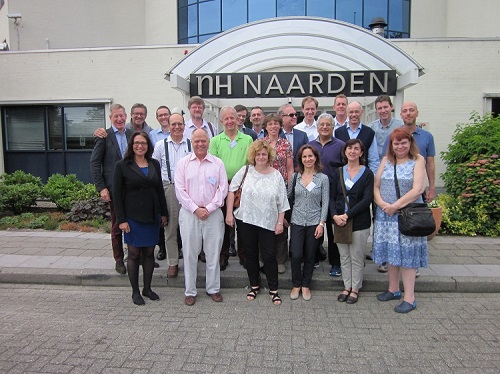Foot surgery in Charcot-Marie-Tooth disease
- Number 221
- Date 10 June 2016
Location:Naarden, The Netherlands
Organizers: M. M. Reilly (UK), D. Pareyson (Italy), J. Burns (Australia), D. Singh (UK).
Participants: Mary M Reilly (London, UK); Davide Pareyson (Milan, Italy); Dishan Singh (Stanmore, UK); Joshua Burns (Sydney, Australia); Michael Shy (Iowa City, US); Matilde Laurá (London, UK); Jonathan Baets (Antwerp, Belgium); Gita Ramdharry (London, UK); Adnan Manzur (London, UK); Isabella Moroni (Milan, Italy); Luca Gaiani (Imola, Italy); Paul Gibbons (Sydney, Australia); Glenn Pfeffer (Cedars Sinai, US); Wolfram Wenz (Heidelberg, Germany); Jan Willem Louwerens (Nijmegen, the Netherlands); Per Henrik Agren (Stockholm, Sweden); Viola Altmann (Nijmegen, the Netherlands); Peter Briggs (Newcastle upon Tyne, UK); Nicolò Martinelli (Milan, Italy) who was able to attend with the Young Scientist Award, made possible by the ENMC Company Forum (see www.enmc.org); Karen Butcher (Christchurch, UK); Fillippo Genovese (Modena, Italy); Marco van der Linden (Eindhoven, the Netherlands).
This workshop was co-sponsored by the CMT UK and INC
![]()
![]()
Description of the workshop
The 221st ENMC workshop entitled “Foot surgery in Charcot-Marie-Tooth disease (CMT)” took place from the 10th of June to the 12th of June 2016 in Naarden, The Netherlands. A multidisciplinary group of 22 participants from 8 countries (UK, Italy, Germany, Belgium, Australia, USA, Sweden and the Netherlands) attended the workshop, including clinical researchers, orthopaedic surgeons (expert in foot and ankle surgery), physiotherapists and three patient representatives from CMT UK, ACMT-RETE and Dutch Neuromuscular Disease Association. They shared ideas and experiences related to surgery in CMT and identified new research areas for the future. It was unique, since a meeting on surgery and CMT with neurologists, orthopaedic surgeons and patient representatives has never been organized before.
Background
Foot deformities in CMT patients are common. A cavo-varus deformity (the typical high arched foot seen in CMT), which represents the most frequent deformity, may increase the level of disability of these patients due to instability and foot pain. Over the years many surgical procedures have beenadvocated for the treatment of foot deformities in CMT. However, the lack of well-documented clinical indications and proven results mean we do not know the optimal surgical treatment of such deformities.
Furthermore, in the orthopaedic literature most of the studies reporting the clinical outcomes after different techniques for treatment of CMT foot deformities use a broad set of clinical scores and are relatively short term, leading to difficulties in comparing studies on the same condition.
Aims
The purpose of this workshop was to provide physicians and orthopaedic surgeons involved in the management of CMT foot deformities with an opportunity to review the surgical interventional techniques from an evidence-based and expert perspective and to promote collaborative multidisciplinary research that produces high-quality studies. Therefore, one of the primary goals of this workshop was to agree some basic principles for foot surgery in CMT patients, including types of procedures, indications and outcomes as well as identify areas for future research.
Discussions and achievements
The first part of the workshop was dedicated to a review of the international contemporary practices in CMT treatment by different participants and a comprehensive review of the literature. This part included an introductory presentation by Dr. Singh focusing on the most frequent surgical approaches to treat foot deformities in CMT patients.
In the second and main part, leading experts gave presentations on foot surgery techniques for CMT patients and a discussion was held regarding all approaches.
In the final day the discussion focused on the timing of surgery, the optimum follow up protocol and the identification of the main research questions going forward.
The following key points were achieved
- Decision on timing and type of surgery should be taken in a multidisciplinary team, including the neurologist and the orthopaedic surgeon.
- The main broad aim of surgery is to achieve a stable well-balanced foot.
- A follow-up protocol is being developed to adopt in the clinical setting and which will be suitable for future research purposes.
- The critical research question going forward is to standardize a follow up protocol in an international setting to allow proper comparison of surgical techniques and to allow proper long term follow of outcomes.
- A working group was formed to take the actions identified forward

The participants of the 221st ENMC workshop on foot surgery in CMT
A full report is published in Neuromuscular Disorders (pdf)
